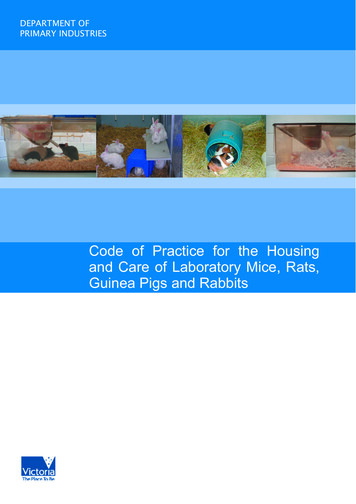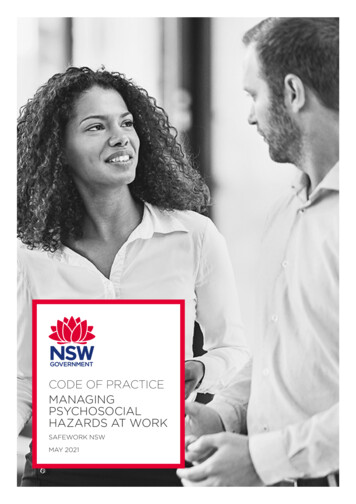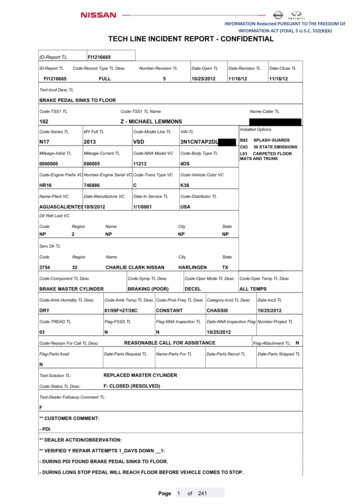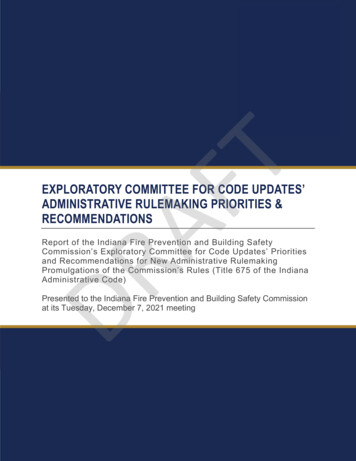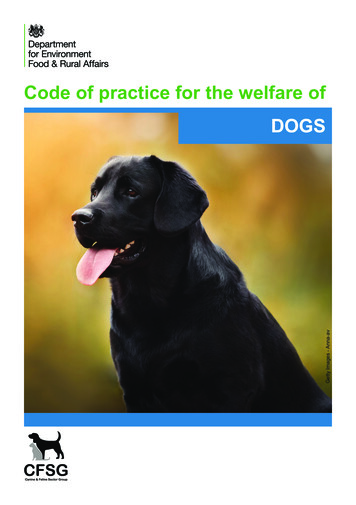
Transcription
Code of practice for the welfare ofGetty Images - Anna-avDOGS
Code of Practice forthe Welfare of DogsPresented to Parliament pursuant to section 15of the Animal Welfare Act 2006December 2017
Crown copyright 2018This publication is licensed under the terms of the Open Government Licence v3.0 exceptwhere otherwise stated. To view this licence, visit /version/3Where we have identified any third party copyright information you will need to obtainpermission from the copyright holders concerned.This publication is available at www.gov.uk/government/publicationsAny enquiries regarding this publication should be sent to us at:Department for Environment, Food and Rural Affairs17 Smith SquareLondonSW1P 3JRISBN 978-1-5286-0171-9CCS1217633178 12/17Printed on paper containing 75% recycled fibre content minimumPrinted in the UK by the APS Group on behalf of the Controller of Her Majesty’s StationeryOffice
ContentsUnderstanding theAnimal Welfare Act 2006. 1How to provide a suitableenvironment for your dog to live in. 2How to provide a suitablediet for your dog. 4PDSAHow to provide for yourdog’s natural needs. 6How to provide the rightcompanionship for your dog. 8How to keep your doghealthy and protect them from pain,suffering, injury and disease. 10Sources of further information. 13
Understanding theAnimal Welfare Act 2006Introduction to the CodeOwning and caring for a dog can be a source of great enjoyment, but you should be awarethat dog ownership is a major responsibility. On average dogs live for around 12 years butsome may live much longer. Consequently, you should think carefully about all factors thatwill affect your ability to care for a dog and whether a dog is suitable for you. Would you beable to provide for all of a dog’s needs? You will need to consider the size of your propertyand the financial and time implications of having a dog as a pet and its exercise needs.Caring for a dog can be expensive and you should consider whether, for instance, youwould be able to afford the cost of routine and unexpected veterinary treatment, or the costof pet health insurance.There is no one “perfect” way to care for all dogs because every dog, and every situation,is different but they all have the same needs. It is up to you to find out what your dog’sprecise needs are and how to meet them. Under Section 9 of the Animal Welfare Act 2006(the Act) you must take such steps as are reasonable in all the circumstances to ensurethat the needs of an animal for which you are responsible are met, to the extent requiredby good practice which are set out in the Act as follows:(a) need for a suitable environment(b) need for a suitable diet(c) need to be housed with,or apart from, other animals(d) need to be able to exhibit normal behaviour patternsIt is up toyou to find outwhat your dog’sprecise needsare and how tomeet them(e) need to be protected from pain,suffering, injury and disease.Under the Act you are always responsible for your dog’s needs.Furthermore, if you are a parent or guardian of a child under the age of 16 years old, youare responsible for any animal that child looks after. If you are unable to care for your dogat any time, you must make arrangements for another suitable person to look after it onyour behalf. It is important to remember that you remain legally responsible for your dog’sneeds, even when you are away. The person with whom you leave your dog will also belegally responsible for your dog’s welfare in your absence.If you own or are responsible for a dog, and fail to meet its welfare needs or cause itunnecessary suffering, you may be prosecuted under the Act.1
How to provide asuitable environmentfor your dog to live inYour dog needs a safe environment and, whether they live inside or outside, they needprotection from hazards. Examples of hazards in the home include: open windows andbalconies, which may be inadequately protected to prevent your dog from falling fromthem; household and garden chemicals; and poisonous plants.Dogs are naturally inquisitive and a dog may put themselves in danger if they are left toexplore unsupervised.Your dog needs a safe, comfortable place to rest, situated in a dry, draught-free area.Living in a cold or damp place can lead to suffering. If your dog lives outside, they will needprotection from adverse weather or other threats. All dogs must be able to avoid things thatfrighten them and need a place to hide where they feel safe.A dog is naturally disinclined to soil its living area and needs regular opportunities to use atoilet area, or it will become distressed. Some dogs may need access to a toilet area morefrequently, for example: very young, very old and those that are ill.Your dogneeds a safe,comfortableplace to rest2Rite Kochmarjova - ShutterstockDogs are vulnerable to heat stress. In hot weather they rapidly become distressed and candie in enclosed areas such as conservatories, vehicles, balconies and outdoor kennels. Onwarm days, these are inappropriate environments for a dog, even for a short time. Theirbodies cannot cool like humans, and so heat can become dangerous very quickly.
Provide your dog with a safe, clean,quiet environment. Make sure thatyou provide adequate protection fromhazards. Provide your dog with a comfortable,clean, dry, quiet, draught-free restarea, which has appropriate ventilationand is lit either naturally or artificially. Provide your dog with somewhere theycan go to avoid things that frightenthem. If your dog is kept in a kennel, youshould check them frequently andensure they are not in danger ordistressed. Provide your dog with access to anappropriate place, away from theirresting area, which they can use as atoilet area regularly as needed and atleast every few hours. Make sure that any place you leaveyour dog is large enough to provide,at all times, a comfortable area witheffective ventilation and temperaturecontrol, and that your dog is able tomove around to ensure its comfort,avoiding becoming too hot or too cold. When you transport your dog makesure they are comfortable and safe atall times. Do not leave your dog unattended insituations, or for periods of time thatare likely to cause them distress orrender them unsafe. Keep your dog under control and safeat all times and do not let them stray. If you are going away and not takingyour dog, make sure they are only everleft with someone who can meet theirwelfare needs.PDSAWhat you should do:3
How to provide asuitable diet foryour dogDiet includes water, and dogs needfresh, clean drinking water at all times.Without water to drink, a dog will becomedistressed and seriously ill.changed suddenly. Strenuous exerciseshortly before, or after, food canalso be harmful.BODY CONDITION SCOREA dog needs a well-balanced diet to stayfit and healthy. Meals designed for peoplemay not provide dogs with the balancednutrition they need and some foodscommonly found in the home, such asgrapes, raisins, chocolate or onions, canbe harmful or even fatal to dogs.1 VERY THIN Very little muscle Easily seenribs, backboneand hipbones No body fatAn individual dog’s nutritional needsdepend on their age, sex, activity, the typeof food they eat, their state of health andwhether they have been neutered. Somedogs, such as those that are pregnant,or nursing puppies, have special dietaryneeds. Diets designed for adult dogs arenot always suitable for growing animalsand puppies. Growing dogs may havespecial dietary requirements. Other dogs,for example; senior dogs, working dogsand those with poor health, may alsorequire a special diet.Dogs can suffer from digestive problemsthat can be caused by their diet being4 Clearly seen ribsand backbone A little fat overhipbones Obviouslytucked-in waist3 IDEAL Can feel ribs, backbone and hipbones, but not prominent Smooth, curved, tucked-in waist Base of tail smooth4 OVERWEIGHTDog images and information: PDSADogs need at least one meal a dayand how much an adult dog needs toeat depends on the type of food, theirbodyweight and how active they are. Ahealthy adult dog should have a stableweight appropriate to their age, sex,breed and level of activity. Dogs should beneither too thin nor too fat. Overfeedinga dog will lead to them becomingoverweight, which can lead to healthproblems. Underfeeding a dog will causethem to lose weight, suffer and cancause health problems2 UNDERWEIGHT No waist and back broader Ribs, backbone and hipbones difficult to feel Fat at base of tail5 OBESE Bulging pot bellyCannot feelribs, backboneor hipbonesThick fatty padsat base of tail
What you should do: Provide your dog with clean freshdrinking water at all times. If necessarycarry water, in a suitable container,with you when clean water is unlikelyto be available. Make sure your dog eats a balanceddiet suitable for their individual needsand maintains a stable weight that isneither over nor underweight for theirage, level of activity, sex, breed andstate of health. Do not let your dogovereat or they will become obese,and do not feed too little or your dogwill be underweight.Be aware that any change in theamount your dog eats or drinks maybe a sign of ill health. If your dog’seating or drinking habits change,consult your vet.Read, and be guided by, the feedinginstructions relating to any dog foodsyou buy but adjust so that your dogdoes not become over or underweight. Provide all dogs (including puppies)that have special needs with diets thatmeet their individual requirements. Feed your adult dog at least onceeach day, unless advised otherwiseby your vet. Do not change your dog’s dietsuddenly. Changes should be madegradually over several days. You should not feed your dog shortlybefore, or after, strenuous exercise. If you are uncertain what to do youshould seek advice on feeding yourdog from a vet, veterinary nurse orother reliable source.Dogsneed constantaccess to fresh,clean drinkingwaterAfrica Studio Shutterstock 5
How to providefor your dog’snatural needsDog training andbehaviourThe way a dog behaves is individual anddepends on their age, breed or type,breeding, rearing and past experiences.However, most dogs are playful, sociableanimals and they enjoy playing togetherwith toys, people and other dogs. Playwith people and other dogs is a valuablesource of interaction and fun, althoughdogs will spend some time playing alonewith toys. They should have regularopportunities for interactive playing.Dogs are intelligent animals and cansuffer from boredom. If your dog is boredand does not have enough to do, theymay suffer or engage in inappropriatebehaviour e.g. excessive barking ordestructive behaviour such as chewingfurniture. Aggressive displays or changesin behaviour, including vocalisation andeating, may indicate that something iswrong with the dog’s physicaland mental health.Dogs experience a range of emotionsincluding happiness, anxiety, fearfulnessand anger. How they behave and theirbody language can help you understandwhat they are feeling and whether they arephysically and mentally fit and healthy.All dogs, in particular puppies, need rest.However, individual dogs have differentneeds and some will sleep for long periodsafter exercise or food; others will need6less rest and will be more active.A dog needs regular exercise and regularopportunities to walk, run, explore, play,sniff and investigate. The amount ofexercise a dog needs varies with age,breed and health. Some individualsneed a lot of exercise and you shouldtake account of this when choosing adog. Young dogs may need to have theirexercise restricted during periods of rapidgrowth to avoid developmental problems.Try to avoid exercising dogs in extremeweather or during events which they mayfind frightening such as firework displays.Training dogs is important to help themlearn to behave appropriately and to makeit easier to keep them under control. Itcan also help strengthen the relationshipyou have with them. It is important to seekprofessional advice to identify/discuss anybehaviour problems and the best trainingoptions for your dog. An incorrect trainingregime can have negative effects on yourdog’s welfare. Reward based trainingwhich includes the use of things that dogslike or want (e.g. toys, food and praise)is enjoyable for your dog and is widelyregarded as thepreferred formof training dogs.Use positive,reward, basedtraining such asa treat, favouritetoy or praise
Training which includes physical punishment may cause pain, suffering and distress. Thesetechniques can compromise dog welfare, lead to aggressive responses and worsen theproblems they aim to address.Puppies need to be carefully introduced to the many noises, objects and activities in theirenvironment, some of which are frightening when first experienced. They also need to beadequately and carefully introduced to many different animals and people so that theylearn how to interact appropriately and behave normally as adults.What you should do:Make sure your dog has enough todo so that it does not becomedistressed or bored. Reward based training methodsincluding food, toys and praise arepreferred in dog training systems. Make sure your dog has access tosafe toys and suitable objects to playwith and chew. Ensure that your dog can restundisturbed when it wants to. Puppiesand older animals may need more rest.Your vet may refer you to a dogbehaviour expert who should have acombination of qualifications, up todate knowledge, skills and experienceand who treats dogs in such a way thattheir welfare is protected. Provide your dog with regularopportunities for exercise and play withpeople or other friendly dogs. Give your dog the exercise itneeds, at least daily unless your vetrecommends otherwise, to keep yourdog fit, active and stimulated.If you become aware of changes inbehaviour, or your dog is fearful of, oraggressive, towards other dogs andpeople, avoid the situations which leadto this and seek veterinary advice. If you are unsure how much exerciseyour dog needs; take advice from yourvet, veterinary nurse or other suitablyqualified dog behaviourist or trainer.You should ensure you prevent yourdog from chasing or attacking anyother animals, including livestock andhorses through use of the lead oravoidance of such situations. You should know the behaviour of yourdog when it is fit and healthy and beable to recognise and understand thesignals your dog and others use whenthey are worried, unsure, angry orhappy, fit and healthy. All dogs need to be trained to behavewell, ideally from a very young age andshould be introduced gradually andpositively to different environments,people and animals.Susan Schmitz - Shutterstock 7
How to provide theright companionshipfor your dogDogs are sociable animals that need,enjoy and value company. Consequently,many dogs do not like being left aloneand may suffer if left without company, orwith nothing to do for long periods of time.Some dogs become distressed and sufferif they are left on their own, even for shortperiods. Experts recommend four hours asthe maximum time period.The length of time individual dogs canbe left varies, depending on factors suchas age, training, previous experience ofbeing left alone, breed or type, lifestyleand housing conditions. However, nodog should routinely be left on its ownfor prolonged periods. If the time aloneis excessive, you can expect behaviouralproblems that are distressing for both youand your dog.Learning to get on with people, dogs andother animals is an essential part of socialdevelopment for a puppy. Puppies thatare deprived of opportunities to developsocial behaviour or who are not introducedcarefully can become withdrawn, anxiousand aggressive as adults. However, if adog has appropriate contact with people,other dogs and animals early in their life,they will be more sociable and this canenhance their quality of life. Dogs thathave not had opportunities to developsocially, perhaps by being removed fromtheir mother or littermates too early,or which have had bad experiencesinvolving people or other animals, may befrightened or aggressive in normal socialsituations or react inappropriately.8Dogs which are frightened showcharacteristic signs such as flattening ofthe ears and lowering the tail or signs ofstress such as excessive panting, lickinglips, hiding, cowering and aggression.Dogs usually get on well with other dogsin the same household, but may needtime to get to know each other.However, they will need to have their ownspace and places to get away from otherdogs if they want to.Dogs get to know the people with whomthey regularly interact.They can become confused anddistressed if the behaviour of those peopleis inconsistent and unpredictable. It isnever acceptable to frighten a dog, causepain, injure or encourage them to behaveaggressively by teasingor tormenting them.Somedogs becomestressed andsuffer if left aloneand may needcompany
Make sure your dog has opportunitiesto spend enough time with peopleand friendly dogs so that it does notbecome lonely or bored. When dogs live together you shouldprovide enough extra resources(e.g. toys, beds, food and water bowlsand places where they feel safe)and space to stop them frombecoming competitive and fightingwith each other. Make sure that your dog is neverleft alone long enough for it tobecome distressed. Encourage your dog to be friendlytowards other dogs and allow it tointeract with friendly dogs on aregular basis. Puppies should be given regular andappropriate opportunities to learnhow to interact with other dogs,animals and people. If your dog is not fully vaccinatedcheck with your vet before mixing itwith other dogs. You should always check health issueswith your vet before allowing yourpuppy to mix with other dogs. Provide your dog with regular exercise,play and training. You should ensure that children arenot left alone with your dog. If you keep more than one dog,you should keep them together forcompany if possible. They will needto get on with each other, but will alsoneed space to get away from eachother when they want to.Marisa HeathWhat you should do: You should ensure that dogs in yourcare are handled properly and arenot stressed or endangered by otheradults or animals, including those wholook after your dog for you when youare away from home Be consistent, kind and gentle in theway you, your family and friends, reactto your dog and do not encourageaggressive or other anti-socialbehaviour. When you are away, make sureyour dog is properly cared for by aresponsible person. When someoneelse is looking after your dog they alsohave a legal responsibility to ensureits welfare, and you should ensure thatthey understand its needs and anyspecial requirements that it may have.You are still legally responsible for thedog even when they are not with you. If your dog is fearful of, or aggressivetowards, other dogs or peopleavoid the situations that lead to thisbehaviour and seek advice from a vet,veterinary nurse or suitably qualifieddog behaviourist or trainer.9
How to keep your doghealthy and protect themfrom pain, suffering, injuryand diseaseDogs do feel pain and have similar painthresholds to people. However, individualdogs and different breeds or types mayshow pain and suffering in different ways.Any change in the way a dog behavescan be an early sign that it is ill, or in pain.Dogs which are ill, or in pain, often changetheir eating and drinking habits. They may: stop or reduce eating and lose weight drink water excessively, drink less ornot at all become withdrawn and unwilling toexercise or play cry when approached or touched show uncharacteristic fear oraggression when approached try to hideThey may also show specific signs of illhealth such as: discharges from the eyes,ears or nose excessive salivation, vomiting,difficulties passing urine,diarrhoea or constipation coughing or wheezing excessively scratching and developingskin sores limping or swelling10This list is for guidance only andis not exhaustive.Dogs are vulnerable to a range ofinfectious diseases and other illnesses.They need protection from seriousinfections, which can be provided byvaccination. Like us, dogs benefit fromroutine health care.Many people choose to have their dogsneutered. If you do not intend to breedyour dog, your vet can advise on neuteringand the welfare benefits of neutering dogs.If you decide to breed your dog, yourvet can advise on the risks of inheritedconditions and exaggerated featuresthat could affect the welfare of thepuppies. Puppies require care, must bemicrochipped before sale and cannot besold under eight weeks. Raising puppiesis difficult and time-consuming, and thepuppies are your responsibility, with thesame needs as any dog under theAnimal Welfare Act.It is a legalrequirement tohave your dogmicrochipped andthe informationkept up to date
Battersea Dogs & Cats HomeFrom 6 April 2016, it is a legal requirementto have dogs microchipped, detailsrecorded on an appropriate, recogniseddatabase and kept up to date. A dog whichcan be easily identified (e.g. by microchip)is more likely to be reunited with its ownerif injured, or lost, particularly if it loses itscollar. This will ensure they receive theprompt veterinary treatment needed ifinjured. Dogs are inquisitive and may putthemselves in danger if left toexplore unsupervised.What you should do: Take sensible precautions to keep yourdog safe from injury. Monitor your dog daily and watch outfor signs of injury, disease or illness.Make sure someone else does this ifyou are away. If you notice changes in your dog’sbehaviour you should contact your vetand follow the advice you are given. You should carefully check your dog’scoat regularly and groom your dog, asnecessary, to maintain a healthy coat. You should ask your vet how oftenyour dog needs a health check, andabout the things you can do to protectyour dog’s health. You should followthe advice you are given. Routine preventive healthcare, such asvaccination and treatments to controlparasites (e.g. fleas and worms), aswell as any current health problemsyour dog may have, is an essentialpart of keeping your dog healthy. Clean up your dog’s faeces to avoiddisease transmission. Take sensible precautions to keepyour dog safe including preventionof access to poisonous food, plants,chemicals and any other hazards. Only use medicines and drugsthat have been prescribed for yourindividual dog. Human products and medicinesintended for other animals can bedangerous to dogs and sometimesfatal. If you are unsure seekveterinary advice. You should always consult your vetif you are concerned that your doghas eaten or come into contact withanything that could be harmful. Your dog is required by law to wear acollar and identity tag when in a publicplace. Collars should be of the correctsize and fit, and should not cause anypain or discomfort. Once your dog ismicrochipped, remember to keep themicrochip database up to date with anychanges in your contact details.11
If you are considering having your dog neutered, your vet will be able to advise youabout the best age to have this done. You should seek the advice of your vet before allowing your dog to breed and take allreasonable steps to ensure that you will be able to provide the care required duringpregnancy as well as finding suitable homes for the puppies. If you recognise signs and symptoms of disease or suspect that your dog is in pain, illor injured; contact a vet promptly and follow veterinary advice regarding their treatment.If at any time you have concerns about the health or welfare of your dog you shouldseek advice from a vet or veterinary nurse.PDSA 12
Sources of further information Your vet. You can contact the Royal College of Veterinary Surgeons tofind details of vets in your area. The Royal College of Veterinary Surgeons(RCVS), Belgravia House, 62-64 Horseferry Road, London, SW1P 2AF:www.rcvs.org.uk – the website has a “find a vet” facility.https://findavet.rcvs.org.uk/find-a-vet/ Local libraries and bookshops for up to date books on dog care. Websites such as: Defra hosted on www.gov.uk – hasinformation on the Animal WelfareAct 2006, Pet Travel Scheme(PETS) and copies of the Code ofPractice for the Welfare of Dogs. Association of Dogsand Cats Homes:www.adch.org.uk Battersea Dogs & Cats Home:www.battersea.org.uk Blue Cross:www.bluecross.org.uk British Veterinary Association:www.bva.co.uk British Small Animals VeterinaryAssociation:www.bsava.com Dogs Trust:www.dogstrust.org.uk PDSA:www.pdsa.org.uk Pet Industry Federation:www.petfederation.co.uk Pet Health Council:www.pethealthcouncil.co.uk Royal Society for the Prevention ofCruelty to Animals:www.rspca.org.uk RCVS’ “Find a vet” service atwww.findavet.rcvs.org.uk for health,nutrition or behavioural advice The Animal Behaviour & TrainingCouncil :www.abtcouncil.org.uk/ The Kennel Club:www.thekennelclub.org.ukIf you wish to take your dog abroadyou can find out how to do this at:www.gov.uk/take-pet- abroad/overview13
This Code of Practice applies to all dogsThe purposes of the Code is to provide practical guidance to help you to comply withthe provisions set out under Section 9 of the Animal Welfare Act (www. legislation.gov.uk/ukpga/2006/45/section/9). It does not tell you precisely how to care for yourdog but it does summarise important things you should know and what to do whenmaking decisions about how best to care for your dog.Breach of a provision of this Code is not an offence itself but if proceedings arebrought against you for an offence under Section 9 of the Act, the Court will lookat whether or not you have complied with the Code in deciding whether you havecommitted an offence.If you are unsure about anything to do with the care and welfare of your dog, youshould always seek advice from an expert such as a veterinary surgeon, mainlyreferred to as vet. You will also find reference within this Code to “other suitablyqualified dog behaviourists or trainers.” These are people who hold the qualificationsand experience to provide expert advice on dog welfare and behaviour.A list of suitable organisations and places to find help are provided onpage 13 of this Code.You can find out more about the legislation relating to dogs at www.defra.gov.uk14
Dog training and behaviour The way a dog behaves is individual and depends on their age, breed or type, breeding, rearing and past experiences. However, most dogs are playful, sociable animals and they enjoy playing together with toys, people and other dogs. Play with people and other dogs is a valuable source of interaction and fun, although




